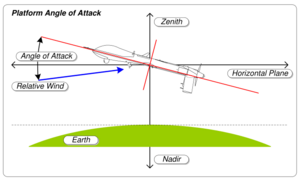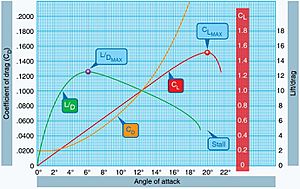Angle of attack facts for kids
The angle of attack (often called AOA) is a super important idea in how airplanes fly! Imagine an airplane wing cutting through the air. The angle of attack is simply the angle between the wing and the direction the air is flowing towards it.
Think of it like this:
- Every wing has a special imaginary line called the chord line. This line goes from the front edge to the back edge of the wing.
- When an airplane flies, air rushes past its wings. This is called the relative wind.
- The angle of attack is the angle formed between that chord line of the wing and the direction of the relative wind.
This angle is key because it controls how much lift a wing creates. Lift is the upward force that keeps an airplane in the air.
Contents
How Angle of Attack Affects Lift
The amount of lift an airplane wing makes changes with its angle of attack.
- When an airplane increases its angle of attack, it generally makes more lift. This is true up to a certain point.
- If the angle of attack gets too high, the lift actually starts to drop! This is because the air stops flowing smoothly over the top of the wing.
Most airplane wings are slightly curved. This curve helps them create some lift even at very small or slightly negative angles of attack. The shape of the wing also affects how much lift it can make.
What is the Critical Angle of Attack?
The critical angle of attack is the special angle where the wing creates the most lift possible. It's also known as the "stall angle of attack."
- If the angle of attack is less than this critical angle, the wing makes less lift.
- If the angle of attack goes above this critical angle, the air flowing over the top of the wing starts to separate. This means the air doesn't stick to the wing's surface anymore. When this happens, the wing loses a lot of its lift.
When an airplane goes above its critical angle of attack, it is said to be in a stall. It's important to remember that an airplane stalls because its angle of attack is too high, not necessarily because it's flying too slowly. The critical angle of attack is usually around 15 to 20 degrees for most wings.
Some modern airplanes have special computer systems. These systems can stop the pilot from increasing the angle of attack too much. This helps prevent the plane from stalling. This feature is called an 'angle of attack limiter'.
Pilots flying planes for short takeoffs and landings (like on aircraft carriers) often use special tools. These tools show them the exact angle of attack. This helps them fly very close to the critical angle of attack safely. This is important for getting the best performance during takeoff and landing.
Flying at Very High Angles of Attack

Some military fighter jets can fly at very high angles of attack. This gives them amazing agility, meaning they can turn and maneuver very quickly.
- A famous example is the "Pugachev's Cobra" maneuver. In this move, the jet briefly points its nose straight up. It flies at a very high angle of attack.
- However, flying at such high angles creates a lot of drag. Drag is the force that slows an airplane down. So, these maneuvers make the plane lose speed very quickly.
Some fighter jets have special parts on their wings called "leading edge extensions." These parts help them fly safely at angles of attack over 45 degrees. This is much higher than regular planes. This ability is useful at high altitudes where the air is thin. It also helps at low speeds, making it harder for the plane to accidentally stall.
Even with this ability, fighter pilots usually don't fly at extreme angles of attack during combat. It slows the plane down too much. It also puts a lot of stress on the plane's structure. Modern flight control systems often limit a fighter's angle of attack. This keeps the plane safe and performing well.
Angle of Attack in Sailing
The idea of angle of attack isn't just for airplanes! It's also used in sailing.
- For a sailboat, the sail acts like a wing.
- The sail's angle of attack is the angle between the sail's curve and the direction the wind is blowing.
- Sailors adjust this angle to get the most power from the wind. This helps the boat move forward.
Images for kids
-
The Wright brothers testing their gliders in 1901 (left) and 1902 (right). The different angles of attack probably at different airspeeds are providing the wanted lift.
See also
 In Spanish: Ángulo de ataque para niños
In Spanish: Ángulo de ataque para niños






